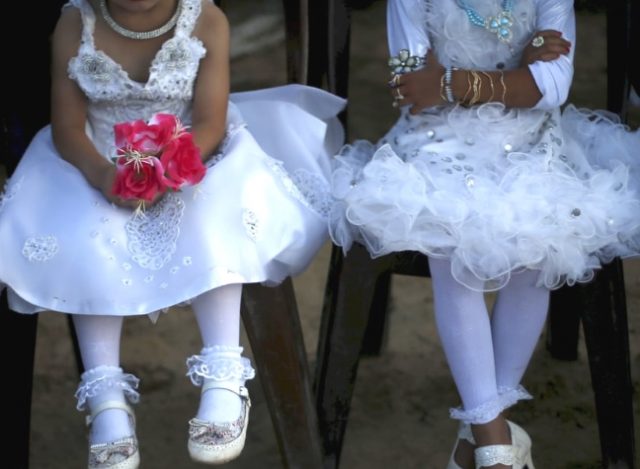For some Filipino girls, turning 18 brings with it visions of their debut, complete with dresses, dances, and drinks.
But many of their sisters around the world cannot share the same prospects, since as many as 41,000 girls become brides each day.
Why does child marriage still exist? The main culprits are poverty, a lack of educational and employment opportunities for girls, and cultural practices and social norms.
Girls in sub-Saharan Africa and South Asia are especially affected by child marriage. In 25 countries that account for the bulk of child marriage, according to Economic Impacts of Child Marriage: Global Synthesis Report, more than one in three girls still marry before 18, and almost one in five have their first child before 18.
The study, published recently by the World Bank and the International Center for Research on Women, acknowledges that, though the prevalence of child marriage has decreased over the past 30 years, it has not been as fast as it should have.
In the Philippines, a recent report by Save the Children shows that Filipino girls are “at least seven times more likely to be married if they are poor than if they come from the richest families,” and that child marriage generally tends to be more prevalent in rural than urban areas.
According to the 2013 National Demographic and Health Survey, 15 percent of young adult Filipino women aged 20 to 24 had their first marriage or began living with their first spouse or partner by age 18.
Economic Impacts of Child Marriage: Global Synthesis Report stresses that governments all over the world must put an end to child marriage not just because of moral and ethical reasons, but for economic ones, as well.
“The costs of child marriage are very high,” it says. “Investing to end child marriage is not only the right thing to do, but also makes sense economically.”
For example, the costs related to the earnings lost for women married as children are significant. Higher educational attainment leads to higher expected lifetime earnings, and child marriage is one of the main reasons for adolescent girls to drop out of school. It is rare that a girl, once married, remains in school.
In 15 countries studied, the researchers found that if women had not married early, there would be $26 billion worth of gains in earnings and productivity today.
“Across countries, child marriage tends to reduce the earnings of populations as a whole by about one percent on average,” the report says. “For the women and households affected, the losses in earnings have even larger impacts.”
In 15 countries studied, a girl marrying at 13 would have 26 percent more children in her lifetime than if she had married at 18 or older. National fertility rates will be 11 percent lower if child marriage is ended.
Ending child marriage will also reduce the share of girls having a child before 18 by three-fourths. On a related note, child marriage is likely the cause of at least 75 percent of girls having children before 18.
Since girls living in poverty are more likely to face child marriage, ending child marriage will benefit the poor the most, the report says.
In terms of welfare benefits that 106 countries studied will reap due to lower fertility and reduced population growth, estimates are at $566 billion by 2030.
The gains become larger each year as the cumulative reduction in population growth keeps growing from one year to the next.
If under-five mortality and stunting tied to child marriage will be stopped, estimates of the benefits for 106 countries are at $98 billion by 2030. Ending child marriage will also enable a large number of children to survive at least until their fifth birthday.
More children will avoid becoming stunted, as well. Stunting occurs when a child, from the time he or she is in the womb up to when he or she is two years old, is malnourished. Without the right nutrients, he or she cannot grow properly and can become too short for his or her age.
Another economic benefit from reduced population growth related to ending child marriage is the reduced pressure on state budgets to provide services to the population. This has “major implications for state budgets in areas such as education and health.”
For example, there will be fewer new cohorts entering school, leading to significant savings for the education budget of many countries.
In just 18 countries studied, budget savings in terms of the cost of reaching universal secondary education by 2030 could reach up to $17 billion.
“The primary motivation for ending the practice (of child marriage) should be the fact that it may lead to substantial risks and suffering for the girls who marry early, and their children,” the report emphasizes.
Adolescent girls have a higher level of maternal morbidity and mortality than women ages 20 to 24, the study says.
But it notes that there is also an impact on boys. They may have to drop out of school once they marry, and resort to taking low-paying jobs to support their new family. This further perpetuates poverty.
Why does child marriage still exist? The main culprits are poverty, a lack of educational and employment opportunities for girls, and cultural practices and social norms.
“In communities where the groom or his family pays a bride price at the time of marriage, which is often the case in parts of Africa, parents may benefit from marrying their daughters early if waiting increases the bride prices,” the report says.
“In communities where the bride brings resources at the time of marriage… more prevalent in South Asia… the required dowry to be paid by parents may be lower if the bride is younger.”
Here are some strategies to prevent or delay early marriage:
Empowering girls with information, skills, and support networks;
Educating and mobilizing parents and community members;
Enhancing the accessibility and quality of formal schooling for girls;
Offering economic support and incentives for girls and their families; and
Fostering an enabling legal and policy framework.
Interventions that promote education, like “cash transfers, school vouchers, free school uniforms, reductions in school fees, teacher training, and life skills curricula” are also likely to help, the study says.





